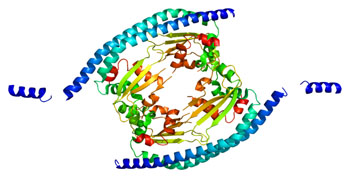Reactivation of p53 Shrinks Tumors in Mouse Model
By LabMedica International staff writers
Posted on 27 Sep 2016
Blocking a protein that inhibits lysine acetylation reversed the inactivation of the p53 protein and resulted in shrinkage of tumors in a mouse xenograft model.Posted on 27 Sep 2016
Most cancers fail to propagate unless the p53 gene is inactivated through mutation or if the p53 protein becomes inactivated. Investigators at the Columbia University Medical Center (New York, NY, USA) looked for proteins involved in inhibition of p53 and of ways to counter their effect.

Image: The structure of the SET protein (Photo courtesy of Wikimedia Commons).
Toward this end, they used a proteomic screen that identified the oncoprotein SET as a major cellular factor whose binding with p53 was dependent on C-terminal domain acetylation status. Acetylation of the C-terminal domain (CTD) of p53 was an early example of non-histone protein acetylation and its precise role has remained unclear.
The protein encoded by the SET gene inhibits acetylation of nucleosomes, especially histone H4, by histone acetylases (HAT). This inhibition is most likely accomplished by masking histone lysines from being acetylated, and the consequence is to silence HAT-dependent transcription. The encoded protein is part of a complex localized to the endoplasmic reticulum but is found in the nucleus and inhibits apoptosis following attack by cytotoxic T lymphocytes.
The investigators reported in the September 14, 2016, online edition of the journal Nature that SET profoundly inhibited p53 transcriptional activity in unstressed cells, but that SET-mediated repression was abolished by stress-induced acetylation of p53 CTD. Moreover, loss of the interaction with SET activated p53, resulting in tumor regression in mouse xenograft models.
Senior author Dr. Wei Gu, professor of pathology and cell biology at the Columbia University Medical College, said, “In the presence of SET, tumors grow much bigger and faster, demonstrating that the p53-SET interaction plays a key role in regulating p53-mediated tumor suppression. Therefore, targeting SET by small molecules or chemical compounds in future may serve as a potential therapeutic strategy for those tumors containing wild-type p53.”
Related Links:
Columbia University Medical Center













